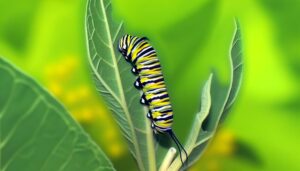How Do Monarch Butterflies Find Milkweed? Discover Process!
You’ll find that monarch butterflies rely on a combination of vision, chemical cues, and instincts to locate milkweed. Their compound eyes enable them to distinguish different wavelengths of light, allowing for effective visual scanning.
Monarchs also detect volatile organic compounds like linalool emitted by milkweed through their olfactory receptors. Memory plays a role, as they can recall abundant milkweed sites and their spatial layouts.
Genetic instincts and environmental signals such as temperature and daylight guide their search. These multifaceted adaptations guarantee they efficiently locate their host plants. There’s more to uncover about these remarkable navigational strategies.

Key Takeaways
The Role of Vision
Monarch butterflies rely heavily on their keen vision to identify and locate milkweed plants. This plant is essential for their survival and reproduction. Their compound eyes give them a broad field of view, vital for spotting milkweed from a distance.
Studies have shown that monarchs can distinguish between different wavelengths of light. This ability allows them to recognize the specific colors of milkweed leaves and flowers.
When you observe their behavior, you’ll see that they hover and scan visually. This helps them in selecting plants that match their visual criteria.
This visual acuity guarantees they find the right host plants for laying eggs. Milkweed is the only food source for their larvae. Their vision-driven search is a critical aspect of their life cycle.
Chemical Cues and Scents
In addition to their visual capabilities, monarch butterflies rely on chemical cues and scents to pinpoint milkweed plants with remarkable accuracy.
They utilize olfactory receptors on their antennae to detect volatile organic compounds (VOCs) emitted by milkweed. Research shows that specific VOCs like linalool and cis-3-hexen-1-ol are particularly enticing.
You’ll find that monarchs can distinguish these compounds from others in their environment, guiding them directly to their host plants.
Studies using gas chromatography and electrophysiological recordings reveal that these receptors are finely tuned to milkweed’s chemical profile. This ability ensures monarchs efficiently locate essential breeding sites, even in dense vegetation.
Such chemical navigation complements their visual search, improving their survival and reproductive success.
Importance of Memory
Memory plays a pivotal role in how monarch butterflies combine their chemical detection skills with past experiences to navigate directly to milkweed plants, ensuring they can maximize their reproductive success.
You’ll find that monarchs remember specific locations where milkweed was abundant. They utilize these spatial memories to return to these sites each season. Observations suggest that their brains encode the spatial layout of milkweed patches.
| Behavioral Aspect | Observation | Evidence |
|---|---|---|
| Spatial Memory | Returning to same sites | Field studies |
| Chemical Detection | Identifying milkweed | Olfactory receptor activity |
| Navigational Skills | Efficient paths | Tracking migration patterns |
| Reproductive Success | High egg-laying rates | Increased offspring survival |
| Memory Utilization | Site-specific behavior | Controlled lab experiments |
These findings highlight memory’s essential role in monarchs’ life cycle.
Genetic Instincts
Countless studies reveal that monarch butterflies possess genetic instincts enabling them to locate milkweed plants even without prior exposure or learned behaviors.
Researchers have identified specific genetic markers in monarchs that are linked to their ability to detect and identify milkweed. These essential behaviors are hardwired into their DNA, allowing newly hatched caterpillars to immediately recognize their host plant.
Detailed observations have shown that even in controlled environments, where butterflies have never encountered milkweed, they still navigate towards it. This evidence suggests that their genetic programming plays a vital role in their survival.
By understanding these genetic instincts, you can appreciate the remarkable evolutionary adaptations that enable monarch butterflies to thrive and perpetuate their species.
Environmental Signals
You’ll notice monarch butterflies utilizing temperature and light cues to locate milkweed, adjusting their behavior based on environmental changes.
They also detect chemical signals emitted by milkweed plants, using olfactory receptors to pinpoint their exact location.
Research indicates that these combined environmental signals are vital for the butterflies’ navigation and successful reproduction.
Temperature and Light Cues
Monarch butterflies rely on specific temperature and light cues to locate milkweed, their primary host plant for laying eggs.
You’ll notice that these butterflies are particularly active during warm weather, typically between 20-30°C. This temperature range optimizes their flight muscles and enhances their ability to search for milkweed.
Additionally, daylight length acts as a critical environmental signal. Monarchs are diurnal, meaning they’re active during the day.
Longer daylight hours in spring and summer align with milkweed’s growth period, providing an ideal time for monarchs to find this essential plant.
Research shows that monarchs use these temperature and light cues to synchronize their reproductive cycle with milkweed availability, ensuring the best chances for their offspring’s survival.
Chemical Signal Detection
Butterflies employ their highly sensitive chemoreceptors to detect specific chemical compounds released by milkweed, enabling them to locate this essential plant for egg-laying.
These chemoreceptors, located on their antennae and feet, can identify volatile organic compounds (VOCs) emitted by milkweed.
Research shows that monarchs are particularly attracted to cardenolides and specific terpenoids, which are unique to milkweed species.
When you observe a butterfly landing on a plant, it’s likely using its tarsi to taste-test the surface, confirming the presence of these compounds.
Studies also indicate that these chemical signals are more potent during certain stages of milkweed growth, guiding monarchs to the most suitable plants. This intricate detection system ensures they find the most suitable sites for their larvae.
Behavioral Adaptations
Through a combination of innate behaviors and learned experiences, these remarkable insects exhibit specialized adaptations that enable them to efficiently locate milkweed.
Monarch butterflies use visual cues, such as the color and shape of milkweed leaves, to identify their host plants. They also display a learned behavior known as ‘traplining,’ where they revisit known milkweed locations within their territory.
Research indicates that monarchs integrate past experiences to refine their search patterns, making them more effective over time.
Behavioral studies have shown that when milkweed becomes scarce, monarchs expand their search radius, demonstrating flexibility and adaptability.
These behavioral adaptations, combined with their acute sensory abilities, ensure that monarch butterflies can reliably find the milkweed essential for their survival and reproduction.
Conclusion
You’re now aware of the incredible methods monarch butterflies use to find milkweed. Fascinatingly, a single monarch can travel up to 3,000 miles during migration, relying on a blend of vision, chemical cues, memory, genetics, and environmental signals.
These adaptations guarantee they locate milkweed to lay their eggs. Each of these mechanisms underscores the complexity and efficiency of nature’s design, highlighting the monarch’s remarkable journey and survival strategies.







Stress could be responsible, as high cortisol ranges could cause
you to pack on pounds no matter your food plan or how a lot
you’re exercising. Metabolic parameters,
evidenced by decreases in HOMA-IR, HbA1c, triglycerides, and will increase in HDL ranges improved in each teams.
Testosterone therapy had no additional advantage, regardless of resulting
in changes in body composition anticipated to be metabolically favourable.
Our study was not designed to look at this end result, and men enrolled were comparatively healthy, with a low proportion of
males being diabetic or dyslipidaemic at baseline.
Human growth hormone leads to a rise within the dimension of a body’s organs.
Nevertheless, you can not goal particular organs for progress if you use human growth hormones.
Nonetheless, this effect is momentary, with glycogen levels normalizing post-cycle.
Research recommend that one in 5 individuals on high-dose prednisone will
gain 22 or extra kilos after one 12 months of therapy (although the weight tends to stabilize after the primary
six months). Your urge for food can even enhance whereas taking prednisone, inflicting you to pack on body fats along with water
weight. Anybody taking prednisone for a very long time can experience some
degree of bone density loss.
Your provider might suggest taking one other steroid
or stopping the steroid use altogether. A balanced food regimen, including a low sodium
food plan with not extra than 2,000 mg a day and better potassium consumption, may help management
fluid retention. High-sodium foods ought to be prevented, and potassium-rich foods like apricots can be added to increase potassium consumption. A
low sodium food regimen can even assist reduce fluid accumulation and should assist control blood pressure.
Step on the human development hormone fuel, hearth up muscle progress and burn by way of
fats shops.
This information explains what cortisol belly fats is, its causes, signs, and how
to effectively handle it. Weight acquire
attributable to extra cortisol can look totally
different for everybody. In addition to appearance,
extra cortisol might change different features of your health that may have an result on your quality of life.
This syndrome happens when small tumors in your pituitary gland,
an space in your mind that helps make cortisol, increase the amount
of cortisol your body produces. Your healthcare supplier may examine your adrenal gland
to see if it’s working correctly.
Alternatively, injectable Primobolan (enanthate) is usually used
and is often dosed at round 300 mg/week. Primobolan doesn’t aromatize, so gynecomastia or water retention are unlikely to be a difficulty.
We have not discovered Equipoise to be exceptionally androgenic,
so these unwanted effects won’t be to the extent
of testosterone, for example. This is due to aromatizing
compounds obscuring Equipoise’s optimistic results on muscle definition. This can be attributed to Winstrol drying out the
body, resulting in much less cushion for the joints. Due To This Fact, older bodybuilders with existing achy joints must be
significantly cautious of Winstrol.
This is as a outcome of a key contributing factor for intertrigo is friction from skin-to-skin rubbing, so
solely places on your physique the place your pores and skin rubs collectively can have intertrigo.
Candida — a sort of yeast, or fungus — is the most typical reason for secondary an infection related to intertrigo.
In many cases of intertrigo, injury to the skin allows micro organism and/or
fungus normally present on the floor of your pores and skin to overgrow.
The warmth, trapped moisture and friction-induced pores and skin injury create an ideal setting for micro organism and fungi
to grow and multiply. This overgrowth of micro organism and/or fungi triggers your immune system to reply, which
results in secondary irritation and a visual rash.
For example, drugs for high cortisol ranges are sometimes used to treat Cushing’s syndrome, a uncommon cause of excessive
cortisol in the body. These drugs work by decreasing the amount of cortisol released by your adrenal glands.
There are exams out there to help detect extra cortisol in your physique.
If you may be experiencing unexplained abdominal weight gain, your
healthcare provider will ask about your medical historical past
as properly as your food regimen, life-style, and general health.
The extra you practice flipping the switch, the more effective you turn into
at managing stress. Stress can set off adjustments, together with
acne, dermatitis, itching, hives, and eczema or psoriasis flares.
Your brain and intestine talk with one another via what’s known as the gut-brain axis .
Stress can affect the health of your digestive tract, resulting in constipation, diarrhea, heartburn, nausea and vomiting,
and more. The extra you practice flipping this switch from stress to rest, the more
resilient to stress you turn out to be. A sedentary lifestyle, however,
can ratchet up your stress response when a stressor strikes,
leading to elevated cortisol. Our previous traumas also can trigger us to stay in a state of hypervigilance .
Because they use separate transporters, consuming both glucose and fructose is another method to improve the amount
of sugar you’ll find a way to take in per hour. Some specialists say that it’s
simpler to shed pounds about 6 months to 1 12 months after stopping corticosteroids.
However it does tend to be easier after you’ve stopped taking the medication. This is as a
result of you’re not combating the results of high cortisol, as previously
discussed. Ginger tea, peppermint, and ginger may help reduce abdomen discomfort.
Managing bloating caused by steroids entails a holistic strategy that includes dietary choices, hydration, and
life-style modifications. It can additionally be necessary to take prednisone with
food to reduce the chances of abdomen problems and avoid wealthy or spicy food
whereas taking this medicine.
Many people on steroids discover elevated fats in the
abdomen, face, and neck. Even should you successfully control steroid-induced weight gain, you’re apt to look
heavier while on these medicine because of this
fat redistribution. The fluid retention and increased
appetite from prednisone usually go away as quickly as the treatment is stopped or lowered to lower
than 10 mg/day. Nonetheless, you should never decrease your dose or cease
taking prednisone without your healthcare provider’s okay.
Common train might help prevent or lessen weight achieve from prednisone
by rising the energy you burn each day. Speak to your healthcare supplier about starting a physical activity routine.
Some weight gain attributed to prednisone use may be as a outcome of lowered bodily activity.
Generally, the higher the dose of the steroid and the longer you’re on it, the more likely you are to come across
weight achieve. Short courses of some days to a couple of weeks don’t
usually produce many unwanted facet effects. Steroids are very efficient at treating certain inflammatory circumstances.
We have discovered this to be essentially the most efficacious oral cycle for getting
ripped. Proviron will enhance Winstrol’s anabolic effects while increasing androgenicity further, aiding fat loss.
Its potent androgenic properties stimulate fats
loss when chopping whereas reducing water levels as a outcome of
it antagonizing the aromatase enzyme. Primobolan will lower endogenous testosterone ranges
notably, but we now have discovered it to be the least suppressive anabolic steroid.
Primobolan just isn’t overly androgenic, so fats loss just isn’t going to be dramatic.
Thus, Primobolan is extra generally utilized to modestly speed
up fat-burning whereas trying to preserve muscle and power on lower calories.
References:
jbhnews